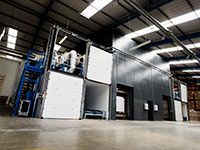 Ethylene Oxide Processing
Ethylene Oxide Processing
Ethylene oxide (also known as EO or EtO) is a low temperature gaseous process widely used to sterilize a variety of healthcare products, such as single-use medical devices. Through the use of a vacuum-based process, EO sterilization can efficiently penetrate surfaces of most medical devices and its lower temperature makes it an ideal process for a wide variety of materials.
What is Ethylene Oxide Processing?
 Ethylene oxide sterilization consists of four primary variables:
Ethylene oxide sterilization consists of four primary variables:
- Gas concentration
- Humidity
- Temperature
- Time
EO is an alkylating agent that disrupts cellular metabolism and reproductive processes of microorganisms. EO penetrates breathable packaging, making contact with all accessible surfaces of the product to deliver the required sterility assurance level (SAL).
What is Ethylene Oxide Used For?
EO is suitable for the sterilization of a wide range of materials not compatible with other methods of sterilization. Products commonly processed with ethylene oxide include:
- Assembled complex devices
- Catheters
- Custom procedure packs
- Equipment with integrated electronics
- Multi-lumen tubing products
- Stents
- Wound care dressings
What are the Benefits of Ethylene Oxide Processing?
- Materials sterilized with EO are not exposed to excessive heat, moisture, or radiation. Therefore, a wide variation of materials, particularly polymeric components commonly used in medical devices, can be sterilized with EO. Material compatibility is described in AAMI TIR 17 (compatibility of materials subject to sterilization).
- Products can be sterilized in their final packaging, since EO will permeate the sealed films and cartons used to package the device.
Standards:
- ISO 11135, Sterilization of health care products – Ethylene oxide – Requirements for development, validation, and routine control of a sterilization process for medical devices.
This international standard outlines the requirement for the validation of an EO process to ensure that product processed through the validated process meets the required SAL.
- ISO 10993-7: Biological evaluation of medical devices — Part 7: Ethylene oxide sterilization residuals
Trace levels of EO and ethylene chlorohydrin (ECH) may remain on products after an EO sterilization process. ISO10993-7 outlines the specific limits of EO and ECH that must not be exceeded in order to ensure product and patient safety. Data on meeting these limits is established during the validation of the EO process.
Ethylene Oxide Support Services:
In addition to ethylene oxide sterilization, STERIS AST provides our Customers with laboratory testing and technical support at every stage of the sterilization design process, from cycle development through routine processing.
TechTeam® Technical Experts
Our EO TechTeam guides Customers through the sterilization validation process, provides solutions for unique project needs, and supports Customers through their regulatory audits as needed.
The EO TechTeam provides technical support for all matters relating to ethylene oxide, including (but not limited to): Technical consultation, process development/optimization, sterilization validation, technical resources, and general research and development.
Testing and Validation Services
Our laboratory testing and product and packaging testing services provide Customers with validation support and microbial testing, ensuring medical devices processed with EO perform as expected for the life of the product, and packaging maintains the sterility of the device until its point of use.
Sustainable EO® Sterilization Services
As part of our commitment to providing innovative and sustainable solutions, STERIS AST has developed the Sustainable EO sterilization services program. Our Sustainable EO services provide Customers with strategies to reduce the EO sterilant used in the sterilization process to achieve the prescribed sterility assurance level.
The program includes innovative approaches to EO sterilization, such as cycle design, validation strategy, and process challenge device design, all focused on the delivery of an efficient and effective process for sterilization of healthcare products.
View our TechTeam Resources to learn more about the ethylene oxide sterilization process.
Ethylene Oxide Summary

ETHYLENE OXIDE
Ethylene oxide sterilization uses a 3-part gas process which includes pre-conditioning, sterilization, and aeration
![]()
Technology Variables
- Exposure Time
- Temperature
- Humidity
- EO Concentration
- Chamber Size
- Single Chamber Or Multi-chamber
- Process Parameters
![]()
Product Considerations
- MATERIAL COMPATIBILITY
- Very few compatibility concerns; liquids generally not recommended.
Packaging must be breathable
- Very few compatibility concerns; liquids generally not recommended.
- DENSITY
- Higher density configurations may impact temperature distribution and processing time
- TEMPERATURE
- Processing conditions exposes product to heat, humidity, and pressure
- GAS PATHWAY
- Gas must reach surfaces requiring sterilization
- CHARACTERIZATION OF NORMAL PRODUCT BIOBURDEN
- Understanding the microbiological challenge of the product relevant for defining a sterilization process
![]()
Possible Effects
line
Trace levels of EO may remain on product after processing and product may require prolonged aeration to reduce to permissible levels
![]()
Exposure Time
line
- HOURS TO DAYS
- (depends on validation approach and time required for degassing)
Why STERIS AST?
As a global leading sterilization and decontamination specialist, STERIS AST has over 40 years experience in providing safe and effective ethylene oxide sterilization.
Related TechTips
Ethylene Oxide Master File Pilot Program FAQ
Q: What is the Ethylene Oxide (EO) Sterilization Master File Pilot Program? A: In an effort to advance innovation in medical device sterilization with ethylene oxide (EO) and reduce the threat of shortages of EO-sterilized medical devices by providing
Study on the Impact of EO Concentration on Product Residuals
A study was carried out to compare the impact, if any, of EO concentration on product EO residual levels determined in accordance with ISO10993-7.
Sustainable EO® Frequently Asked Questions
As part of our commitment to providing innovative and sustainable solutions, STERIS AST has developed the Sustainable EO® sterilization services program.
Overview Of Sterilization Technology Comparison
Learn more about our global offering, which includes electron beam, gamma, X-ray, and ethylene oxide technologies



